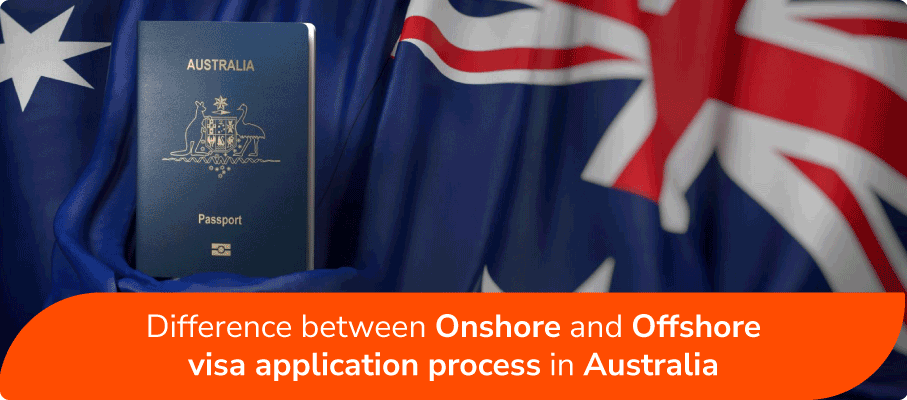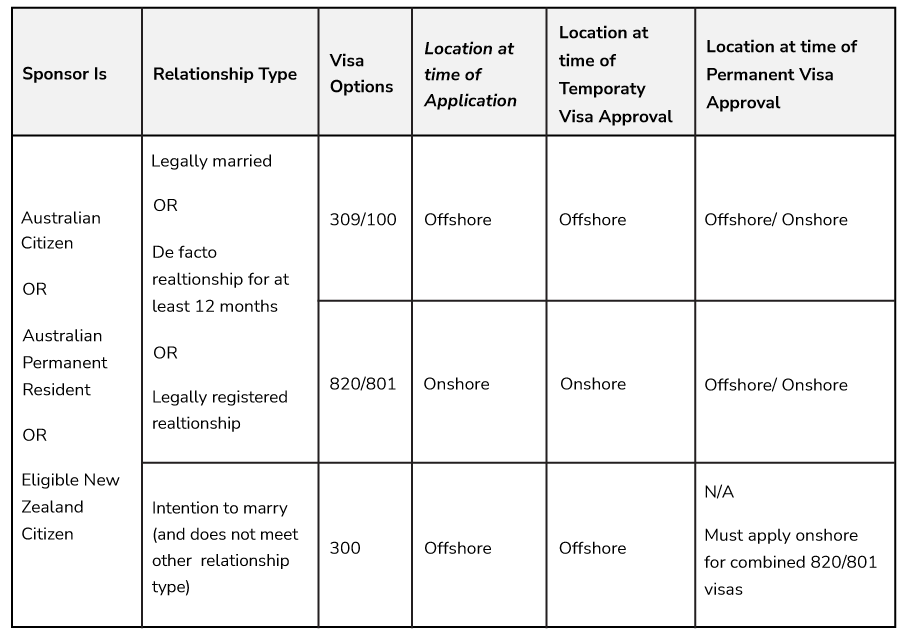
Australia has been a dream destination for many seeking a new life or better opportunities. Understanding the visa application process is crucial if you’re considering moving to Australia.
You have a wide range of visa options for Australian immigration. Among many visa options, a partner visa is categorized into onshore and offshore.
A partner visa in Australia is a visa that allows a partner, whether in a husband/wife relationship or a de facto relationship, to reside in the country temporarily or permanently. The partner must be in a relationship with an Australian permanent resident, an Australian citizen, or an eligible New Zealand citizen.
The Australian Partner Visa allows an Australian citizen’s spouse or de facto partner to reside and work in Australia. There are two methods to apply for this visa: the Onshore Partner Visa application (subclass 820/801) or the Offshore Partner Visa application (subclass 309/100).
Starting with their basic descriptions, Australia’s Onshore and Offshore visa application processes differ significantly. An offshore visa application is made while you are outside of Australia. If you apply for your visa while in Australia, this is referred to as an “onshore application.”
This article will explore the distinctions between these application types and provide essential tips for successful visa lodgement.
Read More: Top employable degrees in Australia you should watch for.
Understanding Onshore and Offshore Visa Applications
Onshore partner visa subclass (820/801)
If you decide to apply for your Australian visa onshore, you must be physically present in Australia both during the application and when the visa is granted. During the onshore application, you’ll be granted a Bridging Visa, which allows you to stay in Australia while waiting for your substantive visa to be processed.
There are different types of Bridging Visas, each with specific conditions. Some may restrict you from leaving Australia while your main visa application is in progress, while others may only allow you to work once your primary visa is finalized.
Remember that onshore applications generally take longer to process than offshore applications and may involve higher fees.
The onshore partner visa is divided into two stages:
Stage 1: Initial application for the temporary (subclass 820) and permanent (subclass 801) partner visas
Stage 2: The second stage is lodged 2 years after the first stage to demonstrate the ongoing nature of the relationship.
To obtain a permanent Partner visa (subclass 801), you must first be granted a temporary Partner visa (subclass 820). For the initial application (stage 1), you need to meet the essential criteria, which include being the spouse (married) or de facto partner of
- an Australian citizen,
- eligible New Zealand citizen, or
- a permanent resident of Australia.
Moreover, for stage 1, you must be in Australia during the lodgment and when the subclass 820 visa is granted. However, for stage 2, you can apply from within or outside of Australia, and the subclass 801 visa can also be granted in either circumstance.
Benefits of getting an Onshore Visa
Applying for an onshore Partner visa grants you access to Medicare throughout the processing period. The current processing time for most stage 1 applications is 21 months. After your visa expires during the application process, you will automatically be granted a Bridging visa A (BVA), allowing you to work and study full-time. If you must travel outside Australia and return, you can apply for a Bridging visa B (BVB) to facilitate your re-entry.
Read More: Complete Guide to Employment Reference Letter.
Offshore partner visa subclass (309/100)
The process of immigrants applying for an offshore or permanent resident visa for Australia while outside Australia. You must be abroad when you apply for the visa and when your visa is approved.
Does this mean you can’t visit Australia before your visa is granted? Not at all. You are welcome to obtain an Australian visiting visa and continue with your application process.
Once the Australian migration department is ready to finalize your application, they will notify you, and you can leave Australia for the visa to be processed. You don’t have to return directly to your home country; you can consider a vacation to New Zealand or any other location outside Australia if you wish to travel. However, you must be outside Australia for the visa to be granted.
If you are contemplating a move or need advice on which visa suits your circumstances best, contact our professionals for expert guidance.
The offshore partner visa is divided into two stages:
Stage 1: Initial application for the combined temporary (subclass 309) and permanent (subclass 100) partner visa.
Stage 2: Submitted 2 years after Stage 1 to demonstrate the ongoing nature of the relationship.
To obtain a permanent Partner visa (subclass 100), you must first receive a temporary Partner visa (subclass 309). Like the onshore partner visa, you need to meet the essential criteria, which include being the spouse (married) or de facto partner of an
- Australian citizen,
- eligible New Zealand citizen, or
- a permanent resident of Australia.
The main difference in the application process is that you must be outside Australia when lodging stage 1, and the subclass 309 visa is also granted while you are outside the country. Another distinction is that you can apply for an offshore partner visa based on an ‘intended’ marriage if you are married when a decision is made on the application. For stage 2, you can apply from within or outside Australia, and the subclass 100 visa can be granted in either circumstance.
Benefits of getting an Offshore Visa
After applying for an offshore partner visa, you can still travel on a temporary visa, like a visitor visa, while processing your application. One advantage of applying for an offshore Partner visa is the potentially shorter processing times for stage 1, usually taking around 13 months for a decision to be made. However, a drawback is that you may have to live apart from your partner for at least one year. Nevertheless, the offshore partner visa could be the ideal choice if other avenues to enter Australia are not viable.
Once the visa is granted, you can access benefits like Medicare, the option to work and study full-time, the freedom to travel to and from Australia as frequently as desired, and the opportunity to attend free English classes.
Editor’s Pick: What is the National Engineering Register?
Requirement for getting a partner visa in Australia
The primary eligibility criteria for both onshore and offshore partner visas are as follows:
- The applicant must be the spouse or de facto partner of an Australian permanent resident or New Zealand citizen.
- Age must be below 18 years.
- Satisfy the health and character requirements of the DHA or immigration department.
- Must not owe any money to the Australian government.
- Provide evidence to prove the relationship is genuine and ongoing, including family gatherings, marriage certificates, or joint accounts.
- If the applicant is in a de facto relationship, there must be evidence that the relationship has been ongoing for over a year.
After satisfying the eligibility requirements and agreeing to the visa conditions attached to the partner visa, the applicant can apply for a partner visa.
Onshore and Offshore Visa Process
The combined visa subclasses 820/801 and 309/100 application process typically involves two stages. Initially, the partner is granted a temporary visa (820 or 309). Subsequently, two years after lodging the combined applications, the Immigration Department will begin assessing the permanent visa application (100 or 801). The permanent visa will be approved if the Immigration Department is satisfied that the partner’s relationship with their eligible sponsor remains genuine.
Sometimes, certain partners may be eligible for immediate permanent residency after receiving the temporary visa. This applies to couples demonstrating an eligible relationship:
- Lasting for at least 3 years, or
- Existing for at least 2 years, along with having a child or children together.
Additionally, those holding a subclass 309 visa or applying for the 820/801 visa may also be able to secure permanent residency if their relationship breaks down due to domestic violence or if the eligible sponsor passes away.
Learn More: Process of ACS RPL Skill Assessment for Software Engineer.
Pathways for Partner Visas Depending on Sponsor and Relationship Status
The table below summarizes the various partner visa pathways:

More Visa Options
Prospective Marriage visa
A prospective marriage visa is a type of visa that allows someone to come to Australia to marry their Australian fiancé. It is for people who are engaged to be married and want to move to Australia to get married and live with their partner as a spouse after marriage. The visa is usually valid for 9 months and requires the couple to marry within that period to apply for a spouse visa afterward.
Bridging visa
When applying for an Australian onshore visa, one visa may expire before the approval of the next one. In such situations, a bridging visa serves as a crucial solution. Acting as a bridge, this temporary visa allows the applicant to stay in Australia while their paperwork is being processed, ensuring they avoid any legal issues associated with unauthorized residence.
Bridging visas come in various types, each offering different benefits and restrictions. Some bridging visas permit work, while others may not. Additionally, certain visas govern the holder’s ability to travel internationally.
Moreover, a bridging visa can also be advantageous for those applying for an Australian offshore visa, enabling the applicant to travel to and from the country. However, it is highly recommended to consult an immigration expert before international travel to ensure a smooth border-crossing experience without legal complications.
Editor’s Choice: What are the great scopes of ICT professionals in Australia?
Conclusion
In conclusion, understanding the difference between Australia’s onshore and offshore visa application processes is vital for anyone considering immigration.
Each approach has unique advantages and challenges tailored to diverse circumstances and preferences. For onshore applicants, the ability to lodge their visa application while already in Australia provides opportunities for bridging visas and continued legal presence during processing.
Conversely, offshore applicants may benefit from more straightforward processing pathways and reduced competition for visa quotas. Whether one chooses to apply onshore or offshore, seeking professional advice and guidance is crucial to navigate the complexities of the Australian visa system successfully. By being well-informed about these distinctions, aspiring migrants can make informed decisions that align with their goals and ensure a smoother and more successful visa application journey.
ACSRPLAustralia can explain these onshore and offshore partner visas to the applicant. However, both these carry similar rights and eligibility requirements. Also, you can get information about skill assessment, RPL reports, and related services with positive assessments.
